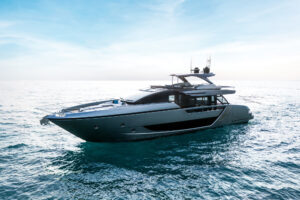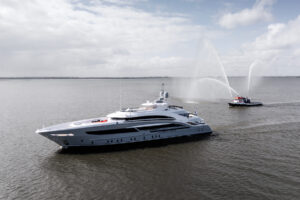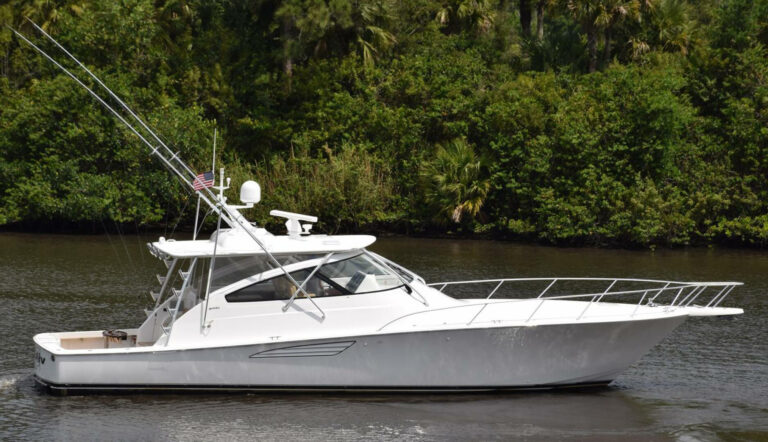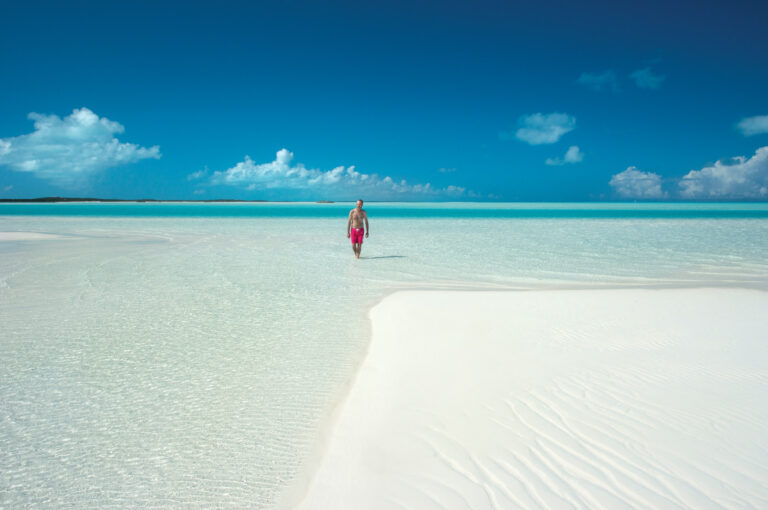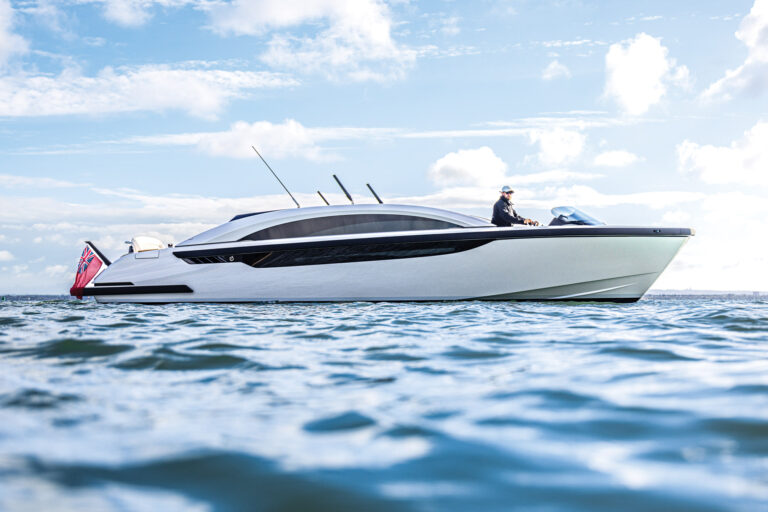Unlike the leaning tower across town, the Akhir 140 from Cantieri di Pisa is a tilt in the right direction. The first yacht in the series, Element, retains much of the straightforward styling that made the earlier Akhirs successful, but her edges are softened a bit. A definite rejection of superfluous curves and ovoid windows sets her apart from many current Italian yachts. The longitudinal black masking of the superstructure allows the yacht to retain her long, lean look and effectively disguises the fact that this is the yard’s first full trideck.
Element‘s hull, while a totally new design, likewise builds on earlier successes. I saw her for the first time a couple years ago just after she was pulled from the mold in Pisa. Since she had no propulsion gear or bottom paint, I could easily appreciate the sleek lines that allow Element to achieve 28 knots with little fuss.
To supply the horsepower needed to propel such a large yacht to this speed, she’s outfitted with a pair of MTU 16V4000 diesels. The sheer mass of these behemoths could sink a lesser yacht, but that is only half the problem. All that horsepower must be transferred into the water to push the boat, and that means a lot of propeller area. Keeping draft to a reasonable limit means simply increasing propeller diameter is not an option. For Element, the solution is modern wide-blade propellers nestled into tunnels.
Straight buttock lines in the afterbody sweep into tunnels that reflect the best of modern flow research. Much like water jets, the tunnel entries on Element‘s hull are long and wide, with parallel sides that fair up into a circular shape at the propeller and then exit the stern with minimal down angle. Unlike older-style designs, these tunnels will not rob the yacht of speed or create erratic performance in turns.
Another concern created by high-horsepower engines and the large propellers they drive is vibration, and the noise and discomfort that can result. The first and most effective step in counteracting this problem is to keep the vibration from transferring to the hull structure. Element uses soft engine mounts that are typical on such a yacht, but goes a step further by isolating the engine from the reduction gear with a flexible coupling.
A recent return visit to Pisa coincided with Element nearing completion, her delivery just days away. She was clearly fulfilling the promise given by her design and by the construction of previous Akhirs. While her limed teak joinery was largely complete, enough of the interior was still open to reveal many details of the yacht’s bones and vital systems. Lamination of the frames to the hull and superstructure was neat and solid. Wiring and piping were orderly and well secured. Such clues to the level of workmanship are largely hidden upon completion. It is an area where less-capable builders can take shortcuts if so inclined, but Element looks as good inside her skin as outside.
Element‘s design is as impressive as her construction. The streamlining of her superstructure is apparent, but it is not achieved by scrimping on headroom or installing unreasonably low railings and windshields. She has ample headroom throughout, but in the on-deck master stateroom, headroom rises to a remarkable 8 feet under the sloping brow forward of the pilothouse.
That same brow lowers the visual impact of the pilothouse, making the yacht look more like a raised-pilothouse design than the full trideck she is. A full-size windshield was retained, however. As a result, Element does not suffer the restricted visibility, forward or to the sides, that plagues too many of the current European offerings. Topsides, the windscreen narrows as it runs aft, but because the fiberglass bulwark rises, the handrails stay at a safe height throughout the length.
Although Element has a Lebanese owner residing in France, the yacht’s arrangement should appeal to American owners, as well. Many older European yachts have crew quarters that are Spartan at best. Element, however, should please even the most picky crew, and as we know, happy crew are essential for happy owners and guests.
There are four crew cabins forward, with upper-and-lower berths in each. The two after cabins each have a head with shower, while the two forward cabins share a centerline head and shower. The captain has a spacious double berth stateroom abaft the pilothouse. There is a large belowdecks crew lounge, and a crew dinette is tucked into the on-deck galley.
Abaft the crew quarters are five guest staterooms, all sharing a single foyer and stairway. When I questioned Alfonso Postorino, marketing director of Cantieri di Pisa, about the safety of this point, he smiled and pointed out an emergency escape hatch leading to the dining room above. It was a small point, but indicative of the expertise this veteran of Italian yacht building brings to Cantieri di Pisa.
The aftermost guest staterooms have queen berths adjacent to the after bulkhead. Well insulated and buffered by fuel deep tanks, the engineroom’s heat and vibration should not be a problem. Hanging lockers run the length of the staterooms on centerline, not only providing generous space, but quelling inter-cabin noise transfer.
Amidships, two more guest staterooms flank the foyer and have twin berths. Lockers here are smaller, but the heads, like those aft, each have a toilet, bidet and shower.
Forward, the VIP suite rivals the master above. A queen berth is to starboard, occupying less than half of the full-beam cabin. To port is a sitting area with a sofa, table and two chairs. Extensive shelving fore and aft is fitted with keepers, and on centerline, a desk and chair are adjacent to the door with an oversize hanging locker and dressing area to starboard. A luxurious head with tub and shower flank the dressing room to port.
The price for such spacious crew and guest accommodations is paid at the after end of the lower deck. The engineroom, while adequate to house and service the machinery, is not overly spacious. The stern garage, abaft the engineroom and a small engineer’s workshop and control room, houses a RIB stowed athwartships.
Forward on the main deck is the master stateroom. Because Element carries full-length side decks, the layout of the master is more longitudinal than the VIP suite’s transverse arrangement, but carries all the same amenities. Additionally, the master stateroom has a his-and-her bath with a centerline tub/shower.
The layout of public spaces is largely traditional, with a dining room and saloon aft on the main deck and a sky lounge abaft the pilothouse. What sets them apart is the décor. Carpets, drapes and upholstery that complement the exterior in shades of black and white offset limed teak joinery. At once sophisticated and casual, it renders Element a cohesive whole.
The top deck does not carry an exterior helm, and so is entirely devoted to guest relaxation. A U-shape settee for eight wraps around a table forward. Amidships, an athwartship bar divides the table from a large sunpad and additional seating aft.
According to Postorino-a veteran of the yacht building industry in Italy who came aboard the company about two years ago with new investors-Cantieri di Pisa, long a successful builder, has entered a new phase. The company is reinvigorated and ready to introduce a number of new models. The Akhir 140 is the first, with an Akhir 125 hot on its heels to fill the gap between the 140 and the existing Akhir 110. There is also a new series of open boats, a first for Cantieri di Pisa. Sixty- and 76-foot models are being introduced this year, and a 95-footer will follow next year. All will have MTU engines.
Contact: Cantieri di Pisa, (011) 39 050 220 551; info@cantieridipisa.it; www.cantieridipisa.it.

